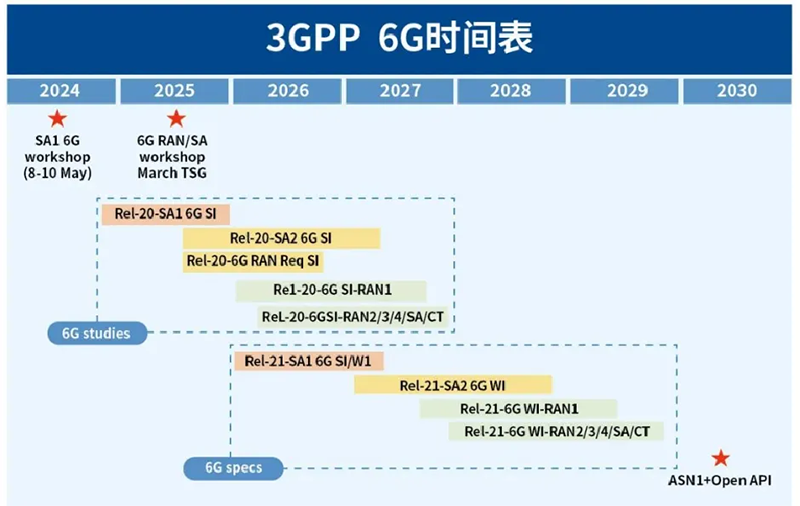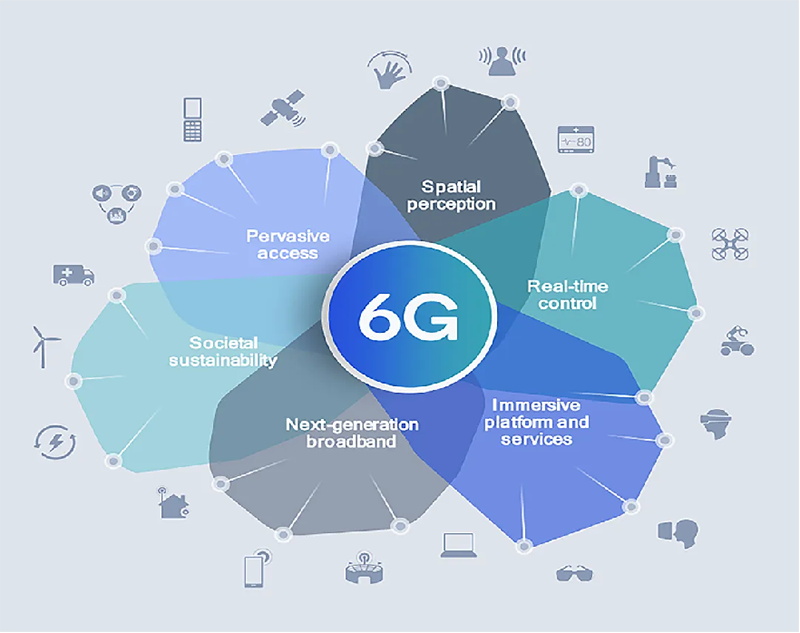From March 18th to 22nd, 2024, at the 103rd Plenary Meeting of 3GPP CT, SA and RAN, based on the recommendations from the TSG#102 meeting, the timeline for 6G standardization was decided. 3GPP’s work on 6G will begin during Release 19 in 2024, marking the official launch of work related to 6G SA1 service requirements. At the same time, the meeting revealed that the first 6G specification is expected to be completed by the end of 2028 in Release 21.
Therefore, according to the timeline, the first batch of 6G commercial systems is expected to be deployed in 2030. The 6G work in Release 20 and Release 21 is expected to last 21 months and 24 months respectively. This indicates that although the schedule has been set, there is still a lot of work that needs to be continuously optimized depending on changes in the external environment during the 6G standardization process.
In fact, in June 2023, the International Telecommunication Union’s Radiocommunication Sector (ITU-R) officially released the ‘Recommendation on Framework and Overall Objectives for the Future Development of IMT towards 2030 and Beyond’. As a framework document for 6G, the Recommendation proposes that 6G systems in 2030 and beyond will drive the realization of seven major goals: inclusivity, ubiquitous connectivity, sustainability, innovation, security, privacy and resilience, standardization and interoperability, and interworking, to support the construction of an inclusive information society.
Compared with 5G, 6G will enable smoother connections between humans, machines, and things, as well as between the physical and virtual worlds, exhibiting characteristics such as ubiquitous intelligence, digital twins, intelligent industry, digital healthcare, and the convergence of perception and communication. It can be said that 6G networks will not only have faster network speeds, lower latency, and better network coverage, but the number of connected devices will also increase exponentially.
Currently, major countries and regions such as China, the United States, Japan, South Korea, and the European Union are actively promoting 6G deployments and accelerating research on 6G key technologies to seize the high ground in 6G standard setting.
As early as 2019, the Federal Communications Commission (FCC) in the United States publicly announced the terahertz spectrum range of 95 GHz to 3 THz for 6G technology testing. In March 2022, Keysight Technologies in the United States obtained the first 6G experimental license granted by the FCC, starting research on applications such as extended reality and digital twins based on the sub-terahertz band. In addition to being at the forefront of 6G standard setting and technology research and development, Japan also has a near-monopoly position in the communication electronic materials required for terahertz technology. Unlike the United States and Japan, the United Kingdom’s focus in 6G is on application research in vertical domains such as transportation, energy, and healthcare. In the European Union region, the Hexa-X project, a 6G flagship program led by Nokia, brings together 22 companies and research institutions such as Ericsson, Siemens, Aalto University, Intel, and Orange to focus on 6G application scenarios and key technologies. In 2019, South Korea released the ‘Future Mobile Communication R&D Strategy for Leading the 6G Era’ in April 2020, outlining the goals and strategies for 6G development.
In 2018, the China Communications Standards Association proposed the vision and related requirements for 6G. In 2019, the IMT-2030 (6G) Promotion Group was established, and in June 2022, it reached an agreement with the European 6G Smart Networks and Services Industry Association to jointly promote the global ecosystem for 6G standards and technologies. In terms of the market, communication companies such as Huawei, Galaxy Aerospace, and ZTE are also making significant deployments in 6G. According to the ‘Global 6G Technology Patent Landscape Study Report’ released by the World Intellectual Property Organization (WIPO), the number of 6G patent applications from China has shown rapid growth since 2019, with an average annual growth rate of 67.8%, indicating that China has a certain leading advantage in 6G patents.
As the global 5G network is being commercialized on a larger scale, the strategic deployment of 6G research and development has entered the fast lane. The industry has reached a consensus on the timeline for 6G commercial evolution, and this 3GPP meeting is an important milestone in the 6G standardization process, laying the foundation for future developments.
Chengdu Concept Microwave Technology CO.,Ltd is a professional manufacturer of the 5G/6G RF components in China , including the RF lowpass filter , highpass filter , bandpass filter , notch filter/band stop filter , duplexer,Power divider and directional coupler . All of them can be customized according to your requrements .
Welcome to our web : www.concept-mw.com or reach us at: sales@concept-mw.com
Post time: Apr-25-2024


